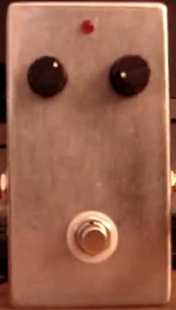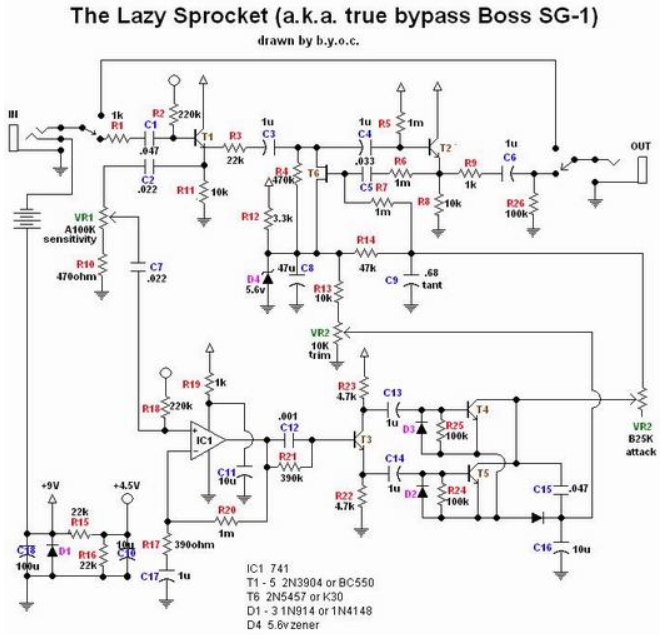Difference between revisions of "Lazy Sprocket"
(→Controls) |
(→Phase Inversion: Unknown) |
||
| Line 29: | Line 29: | ||
We think understanding that this is how the pedal works is sort of odd too. It's not consistent with how other pedals operate. It does operate "correctly" according to the controls and what they do, but the human mind actually prefers consistency even over "correctness". Odd, but then, that's how it works... | We think understanding that this is how the pedal works is sort of odd too. It's not consistent with how other pedals operate. It does operate "correctly" according to the controls and what they do, but the human mind actually prefers consistency even over "correctness". Odd, but then, that's how it works... | ||
| − | ==Phase Inversion: | + | ==Phase Inversion: No== |
| + | For reasons that are not obvious to us, BYOC labeled the transistors in their schematic as "T", despite the common convention of such devices being labeled "Q". | ||
| + | {| class="wikitable" style="left; margin-right:20px; background-color:#eeffee;" cellpadding="10" | ||
| + | |- | ||
| + | ! Schematic ID || Electronic Part || Action || Phase State | ||
| + | |- | ||
| + | | Q1 (T1) || 2N3904 || Does Not Invert || Not Inverted | ||
| + | |- | ||
| + | | Q2 (T2) || 2N3904 || Does Not Invert || Not Inverted | ||
| + | |} | ||
| + | |||
| + | There's some things that are interesting to note here... | ||
| + | # We're only listing 2 "active" electronic parts, even though the schematic shows a total of five transistors and an integrated circuit. | ||
| + | # The reason for that is because the instrument signal only passes through T1 and T2. | ||
| + | # The other transistors and the integrated circuit are sensing the envelope of the signal ('''"Sens"''') and modifying volume swells ('''"Attack"''') as a result - They're not "touching" the signal that's come into, and is going out of the pedal. | ||
==Pedal Manual== | ==Pedal Manual== | ||
Revision as of 06:24, 12 September 2018
The BYOC Lazy Sprocket is a clone of the now-very-difficult-to-obtain Boss SG-1 Slow Gear pedal. This pedal uses an envelope filter.
We can hear you saying, "An envelope filter? No way, that's for wah-wah stuff..."
Well, yes, and no. The Lazy Sprocket also filters your instrument's signal envelope. However, instead of using the intensity of the signal envelope to filter different frequency bands across the signal (like a Wah-wah), the Lazy Sprocket uses the intensity of the signal envelope to swell volume levels.
Controls

The Lazy Sprocket has the exact same controls as the original Slow Gear:
- Knob 1 - "Sens": This is the sensitivity used to detect the envelope. Turning the knob clockwise increases sensitivity, making it EASIER for the effect to be triggered
- Knob 2 - "Attack": This is how quickly the instrument sound will be ramped up. Turning the knob clockwise increases note or chord attack.
Bypass: True
The BYOC Lazy Sprocket is True Bypass.
General Information
The one thing that's unusual about the Lazy Sprocket is that it operates in a fashion opposite of most pedals that you might be familiar with. For example, let's suppose you have a distortion pedal that you love. As a result of using it a lot, you've learned, and come to expect, that turning all the knobs clockwise as far as they will go will result in the most extreme effect from the pedal. In fact, this is how most pedals work: overdrives, delays, phasers, tremolos, etc... Full blast on knobs = full blast on effects. So this is what we've come to expect.
However, this is where the Lazy Sprocket is different. Maximizing the Sens and Attack controls don't make the effect more extreme, they make the effect less extreme, and more like what your instrument would sound like without it. A very very sensitive envelope setting means that the effect will be triggered immediately. An aggressive attack will make your signals volume ramp more quickly.
Ironically, the most extreme settings for the Lazy Sprocket are for the Sens and Attack to be fully counter-clockwise. It requires a strong signal for the effect to be triggered (and for sound to come through) and it ramps up the volume slowly, not immediately.
We think understanding that this is how the pedal works is sort of odd too. It's not consistent with how other pedals operate. It does operate "correctly" according to the controls and what they do, but the human mind actually prefers consistency even over "correctness". Odd, but then, that's how it works...
Phase Inversion: No
For reasons that are not obvious to us, BYOC labeled the transistors in their schematic as "T", despite the common convention of such devices being labeled "Q".
| Schematic ID | Electronic Part | Action | Phase State |
|---|---|---|---|
| Q1 (T1) | 2N3904 | Does Not Invert | Not Inverted |
| Q2 (T2) | 2N3904 | Does Not Invert | Not Inverted |
There's some things that are interesting to note here...
- We're only listing 2 "active" electronic parts, even though the schematic shows a total of five transistors and an integrated circuit.
- The reason for that is because the instrument signal only passes through T1 and T2.
- The other transistors and the integrated circuit are sensing the envelope of the signal ("Sens") and modifying volume swells ("Attack") as a result - They're not "touching" the signal that's come into, and is going out of the pedal.
Pedal Manual
http://byocelectronics.com/swellinstructions.pdf
Schematic
Artists
- Marty Friedman
- Billy Corgan
- Additional Sources
